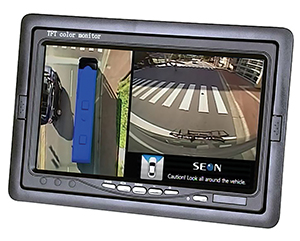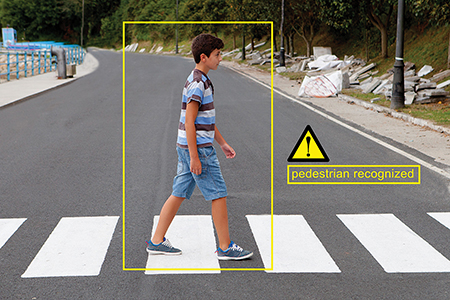By Lori Jetha
![]() Sixty-three pedestrians lost their lives in single vehicle accidents involving buses in 2015. That represents an 11 percent increase in fatalities involving buses over 2014. This disturbing trend is fueled by pedestrians focused on mobile device screens, urban congestion, distracted motorists, and blind spots around the bus itself. At a 2016 bus safety symposium, former National Highway Traffic Safety Administration (NHSTA) Administrator Dr. Mark Rosekind urged participants to look at “changes that give operators the best visibility… advanced technologies that have the potential for exponentially increasing pedestrian protection.”
Sixty-three pedestrians lost their lives in single vehicle accidents involving buses in 2015. That represents an 11 percent increase in fatalities involving buses over 2014. This disturbing trend is fueled by pedestrians focused on mobile device screens, urban congestion, distracted motorists, and blind spots around the bus itself. At a 2016 bus safety symposium, former National Highway Traffic Safety Administration (NHSTA) Administrator Dr. Mark Rosekind urged participants to look at “changes that give operators the best visibility… advanced technologies that have the potential for exponentially increasing pedestrian protection.”
To improve pedestrian safety and prevent bus accidents, transit agencies should look at several emerging technologies that increase driver visibility and correct unsafe driving behaviors.
#1 – Advanced driver-assistance systems (ADAS)

Lane-departure warnings, blind spot detection sensors, forward collision alerts and back-up cameras have gradually been introduced into the consumer automotive market over the last several years as standard vehicle safety features. Look for these features to become more readily available to the transit bus market in the near future. Cameras, radar, lidar, and microwave sensor systems have also proven effective in detecting unsafe conditions that could lead to collisions and alert the driver to take corrective action.
Agencies should also be aware of the updated Federal Motor Vehicle Safety Standard (FMVSS) 111 rear visibility requirements that went into effect in May 2017 for passenger vehicles under 10,000 pounds. These changes expand the required driver field-of-view in order to reduce back-over accidents. Any rear-view camera systems installed must be in compliance with the revised standard. Look for guidance in selecting the right after-market driver-assistive technologies from experienced camera and sensor providers.
#2 – Perimeter safety solutions
2016 brought the introduction of ‘around vehicle monitoring’ (AVM) technology to give drivers better visibility around the perimeter of the vehicle. Views from four cameras strategically placed on each side of the bus are stitched together to deliver a bird’s eye view, and the view relevant to the current operating condition, to the driver to help prevent collisions with nearby objects and pedestrians. Look for enhancements to this technology that display sensor data and deliver audible alerts to drivers so they can take corrective action to avoid injuries and vehicle damage.

Although a relatively ‘low-tech’ solution, proper mirror installation is also important for improved driver visibility in large transit vehicles. Training on pre-trip mirror adjustment should continue to be reinforced in all operator safety programs.
#3 – Driver performance management software
94 percent of vehicle crashes involve human error, so efforts to coach and reward safe driving behavior are an essential part of any safety improvement program. Research on human behavior has proven that measurement and competition are two effective means of changing entrenched habits. Driver performance management applications aggregate and prioritize the huge volumes of vehicle operating data coming in from computer aided dispatch/automatic vehicle location (CAD/AVL), route tracking, and video surveillance systems into reviewable video event records that supervisors can use to coach better driving behavior. GPS, video, and vehicle sensor data is analyzed and combined to produce driver rankings and scorecards. The gamification of driver scoring as well as incentives or rewards for good driving habits can lead to sustainable accident reduction.

#4 – Pedestrian detection technology
Bus A and B pillars can create significant blind spots that pose real danger to pedestrians, particularly in a left-turn scenario. New pedestrian detection technology brings together specialized cameras with advanced video analytics to create a ‘visual sensor’ that can detect pedestrians located in common bus blind spots and issue audible warnings or visual alerts of an impending collision to bus drivers and pedestrians. Unlike traditional video surveillance technology that simply records incidents for later review, pedestrian detection systems can actually assist drivers in preventing an accident.
Integration is key to sustainable accident prevention
Each of these four emerging technologies have one thing in common: they all combine video, sensor, and telematics data to deliver actionable information to drivers for the prevention of accidents. Data integration from multiple systems or components is key to sustainable accident prevention. 63 lives lost is unacceptable and preventable. Giving drivers greater visibility and advanced warning of potential collisions will lead to reduced accident rates, lower liability claims, and ultimately save precious lives.
Lori Jetha serves as marketing manager for Seon, a video surveillance and fleet management company based on Coquitlam, BC, Canada.
